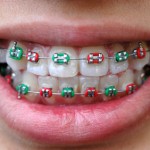
Fixed banded orthodontic treatment is commonplace not only amongst children by but increasingly in adults. Being able to successful bond these brackets to the teeth during treatment is a one factor for successful treatment. The aim of this review was to compare the effects of different dental etchants and different etching techniques for the bonding of fixed orthodontic appliances.
The authors note 4 areas of controversy as important reasons to do this review. These are:-
- the effectiveness of different dental etchants;
- the optimal etching duration and concentration of specific etchants;
- the effectiveness of self etching primers (SEPs compared with conventional etchants;
- the clinical efficacy of different SEPs.
Searches were undertaken in a number of electronic databases, the Cochrane Oral Health Group’s Trials Register, the Cochrane Central Register of Controlled Trials (CENTRAL), Medline, Embase, Chinese Biomedical Literature Database, the WHO International Clinical Trials Registry Platform and the National Institutes of Health Clinical Trials Registry. Handsearching was also conducted in some journals. There were no restrictions on language or date of publication. Randomised controlled trials (RCTs) were included. Split mouth designs using a quadrant approach were accepted. Cochrane methodological approaches were followed.
- 13 trials (417 patients 7148 teeth/brackets) were included. Ten were considered to be at high risk of bias, 2 at low risk and 1 study at unclear risk.
- 11 studies compared the effects of SEPs with conventional etchants. 5 studies (221 patients, 5-37 months of follow up) contributed to a meta-analysis providing low-quality evidence that was insufficient to determine whether or not there is a difference in bond failure rate between SEPs and convention etchants (risk ratio 1.14; 95% confidence interval (CI) 0.75 to 1.73;).
- 2 studies compared two different SEPs. Both studies reported bond failure rate, with one of the studies also reporting decalcification. However, as both studies reported outcomes only at the tooth level, there were no data available to evaluate the superiority of any of the SEPs over the others investigated with regards to any of the outcomes of this review.
The authors concluded
We found low-quality evidence that was insufficient to conclude whether or not there is a difference in bond failure rate between SEPs and conventional etching systems when bonding fixed orthodontic appliances over a 5- to 37-month follow-up. Insufficient data were also available to allow any conclusions to be formed regarding the superiority of SEPs or conventional etching for the outcomes: decalcification, participant satisfaction and cost-effectiveness, or regarding the superiority of different etching materials, concentrations or etching times, or of any one SEP over another. Further well-designed RCTs on this topic are needed to provide more evidence in order to answer these clinical questions.
Comment
In this review the problems of using tooth-level analysis rather that patient based analysis are discussed. As a consequence the analysis of those studies using this approach often failed to take into account pairing of data. Analysis also tended to ignore clustering . As a result only 5 studies were included in the meta-analysis. In an earlier review by Fleming (Dental Elf – 3rd July 2012) data was analysed at tooth level and suggested only a slight chance that conventional etching was worse than etching using an SEP.
Links
Hu H, Li C, Li F, Chen J, Sun J, Zou S, Sandham A, Xu Q, Riley P, Ye Q. Enamel etching for bonding fixed orthodontic braces. Cochrane Database of Systematic Reviews 2013, Issue 11. Art. No.: CD005516. DOI: 10.1002/14651858.CD005516.pub2.
